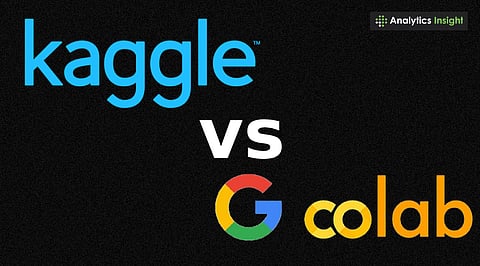

Kaggle provides free GPUs, datasets, and competition-focused learning.
Colab allows flexible coding, collaboration, and paid access to stronger GPUs.
Choosing between them depends on project size, collaboration needs, and computing power.
Students and beginners who want to learn machine learning or artificial intelligence often face a common hurdle of figuring out where to practice their coding skills. Kaggle Notebooks and Google Colab are the two most popular choices for such users, as they offer free, cloud-based environments to write and execute Python code without needing powerful hardware.
This article discusses the features and usability of each platform, helping users decide which one suits their needs.
Here is a detailed overview of how Kaggle and Google Colab differ, and when to choose one over the other for your projects:
Kaggle Notebooks is part of Kaggle, a Google-owned platform known for machine-learning competitions and free datasets. The notebook tool helps users explore data, test models, and share their work with others.
Google Colab, short for Colaboratory, is based on Jupyter notebooks and supported by Google Research. It provides a flexible, cloud-based space to run Python code, train models, and connect with Google Drive and other Google tools. Kaggle is closely tied to competitions and data resources, while Colab acts more like a general-purpose online coding lab.
Also Read: Google Colab vs Jupyter Notebook: Which One is Better?
Both platforms provide free access to GPUs, which are important for deep learning. The main differences are in session length and hardware.
Kaggle usually provides Tesla T4 or P100 GPUs. Sessions can last about nine hours, with a weekly limit of around 30 GPU hours. Public datasets are easy to use directly on the platform, which makes testing models faster.
Google Colab’s free version offers GPUs like T4 or K80. Sessions can last up to 12 hours, but may disconnect if the system is idle. Free GPU access on Colab is less predictable because heavy demand can mean waiting longer or getting slower GPUs.
For small projects, both platforms are useful. Kaggle provides predictable limits, while Colab can feel inconsistent on the free plan.
Google Colab has Pro and Pro+ plans that give access to stronger GPUs like V100 or A100, longer session times, and priority use when demand is high. This helps train large models or run frequent experiments.
Kaggle does not have paid plans. Everything on Kaggle is free, which is good for students or anyone who wants to experiment without spending money. The downside is less flexibility in hardware and session length.
Also Read: Top Kaggle Competitions for Data Science Enthusiasts
Exploring datasets already on the platform
Participating in competitions to practice skills
Sharing work publicly because notebooks can be forked and reused
Short to medium training runs where free GPU access is enough
Projects that need Google Drive or BigQuery integration
Real-time collaboration with multiple users editing notebooks together
Training large models with stronger GPUs in paid plans
Longer experiments need more memory and computing power
A student learning handwriting recognition may find Kaggle easier because datasets like MNIST are already available, and results can be shared quickly. A group of friends creating a large image classifier for a hackathon may prefer Colab Pro because it offers faster GPUs and better collaboration tools.
Both platforms have limits. Sessions can disconnect without warning, temporary storage can be lost if files are not saved, and free GPU access is never guaranteed. Colab can be unpredictable, while Kaggle’s fixed limits can make large projects difficult. While both tools have preinstalled libraries, which is helpful, advanced setups may need extra steps.
Kaggle and Colab serve different purposes. Kaggle is steady, free, and community-focused, making it a good start for beginners and those learning through competitions. Colab is more flexible with paid options for stronger hardware, which suits projects needing more computing power or collaboration.
The choice completely depends on the user’s requirements. For smaller experiments and learning, Kaggle is the best choice. However, for complex tasks, using Colab Pro can be beneficial.
1. Which platform is better for beginners learning AI and machine learning?
Kaggle is ideal for beginners due to free datasets, competitions, and predictable GPU access.
2. Can I access free GPUs on both Kaggle and Google Colab?
Yes, both provide free GPUs, but Kaggle has predictable limits, while Colab’s access may vary with demand.
3. What advantages does Colab Pro offer over free Colab?
Colab Pro gives stronger GPUs, longer sessions, and priority access, ideal for large models and extended experiments.
4. Which platform is best for collaborative projects?
Colab excels in real-time collaboration, allowing multiple users to edit notebooks together seamlessly.
5. Are there limits to using Kaggle and Colab notebooks?
Both have session limits, possible disconnections, and temporary storage; free GPU access is never guaranteed.
